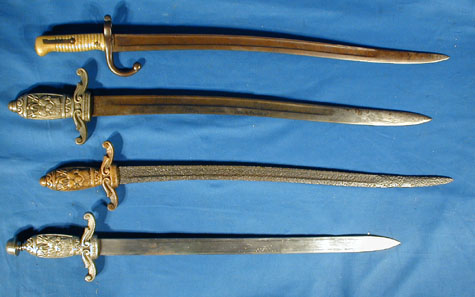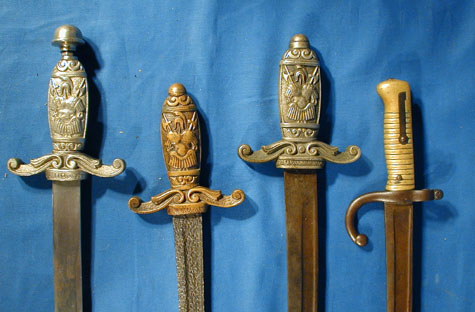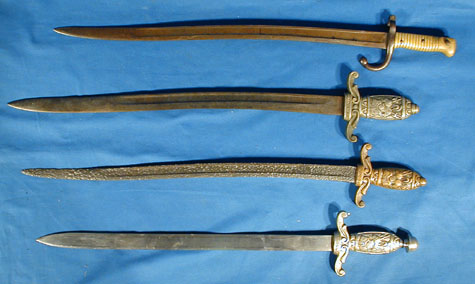Yataghan sword bayonets





length: 27 1/2"
Here's an 1871 French yataghan sword-bayonet and three derivatives.
I've been seeing the short-sword styled versions for about 15 years, and
most folks who have one in their collection list them as "unknown swords".
I've recently heard two alternative explanations: 1) The original
sword-bayonets were unpopular with the troops and their use was rapidly abandoned. The
surplus blades were rehilted into artillerist-style short swords in the
1890's and
exported to Third World countries, most notably in Central and South America.
Examples are the second and third blades pictured here. 2) The unpopular
bayonets were sold off to American fraternal regalia suppliers, who rehilted
them into short swords that quickly became associated with the Masonic
Yorkist Rite. The bottom pictured sword is either a variant Yorkist sword
or a 1920-ish theatrical variation.
replies received:
To the contrary, the bayonet was so popular that Germany required a large amount to be given to them as a tribute after the french lost the war. German soldiers complained about the french writing on their weapons. As a result, many were sold to arms dealers who rehilted for other markets. This increased as the gras was introduced. Germany also gained the right for their arms manufacturers to mass produce them. Within a few years, France began competing on the world scene to enhance their arms industry. England also contracted for limited production. -- junkman5106
These hilts have been identified as having been sold through
Bannerman's. I've
seen several other blade types mounted in the same hilt. -- MarkM
Hal,
You always come up with the most interesting stuff!!!! The French bayonet shown is actually the M1866 series Z sabre bayonet, which was used with the Chassepot rifle. The yataghan blade bayonet appeared on the M1842 French sabre bayonet, and soon became de riguer on bayonets of many armies. The reason for this was clearly a matter of fashion rather than practicality, as Burton notes on the yataghan,"...as a bayonet it lost all it's distinctive excellence;the forward weight, so valuable in cutting with the hand, made it heavy and unmanagable at the end of a musket".(p.134). He notes that the thrust with these required considerable strength. These unpopularity of this form of bayonet is not surprising, yet during the Civil War, the U.S. had continued it's penchant for French military fashion with Zouave units. These flamboyant Turkish uniformed troops also had muskets with bayonets of this form , and a number of yataghan blade bayonets appeared for both U.S. and Confederate forces. After the war ended, U.S. militia and national guard units continued to wear zouave dress. Well into the 20th century, zouave drill teams continued. I still remember as a young boy seeing one of these units deliver a most stirring and impressive performance.It seems that military fraternal groups such as American Legion etc. may have had such units.
blade: 22 3/4"
blade width: 1 1/8"
grip: 4 1/4"
guard: 4"
weight: 1 lb 8 oz
all measurement are from the original 1871 model
What do ya'll think?
ref: "Les Zouaves" Ron DaSilva, Toy Soldier, Spring,1989,
(pp.39-44)
"The Magnificent Zouaves" Robin Smith, Military Illust-
rated, Nov.1994 #78, pp.15-17
"French Military Weapons 1717-1938" Maj.J.Hicks
Germany was making yataghan blade bayonets in the 19th c. for export, and Central and South America were among their leading clients. It would seem plausible that the interest in zouaves and exotic military fashion would likely apply to these rehilted yataghan bayonet blades, and to the various military fraternal organizations. -- Jim McD